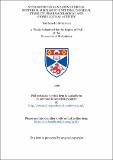Files in this item
Nitrosothiols as no-donor drugs: Synthesis, mechanistic studies, chemical stability, pharmacological and physiological activity
Item metadata
| dc.contributor.advisor | Butler, Anthony (Anthony R.) | |
| dc.contributor.author | Al-Sa'doni, Haitham H. | |
| dc.coverage.spatial | 247 p. | en_US |
| dc.date.accessioned | 2018-07-10T13:25:52Z | |
| dc.date.available | 2018-07-10T13:25:52Z | |
| dc.date.issued | 1996 | |
| dc.identifier.uri | https://hdl.handle.net/10023/15187 | |
| dc.description.abstract | S-Nitrosothiols (RSNO) are an important class of NO-donor drugs. They have been used clinically and occur naturally where they may have a role in several biological and physiological processes in the human body. The medical importance of S-nitrosothiols has been highlighted recently by several reports which describe the clinical use of GSNO (13) to inhibit platelet aggregation during coronary angioplasty and also to treat a form of preeclampsia, a high blood pressure condition suffered by some pregnant women. We set out to extend the range of compounds of this type by synthesising a novel series of biologically active S-nitrosothiols (1-13) and to look for a correlation between structure, chemical stability, and physiological activity. The situation has been complicated by the recent discovery that the main route for the release of NO from S-nitrosothiols is a copper- catalysed process. A detailed kinetic study of copper ions, and thiols on the stability of the compounds we synthesised has shown that the dominant pathway for the decomposition of S-nitrosothiols in most circumstances is one catalysed by Cu⁺ ions. We suggest that Cu⁺ ions are formed by the reaction of Cu²⁺ ions with thiol, present in the S-nitrosothiols as an impurity. The implications of this discovery for an understanding of the biological action of S-nitrosothiols is suggested. All the new S-nitrosated dipeptides (2-12) examined show less susceptibility to copper (I)- catalysed release of NO than SNAP (1) but are more reactive than GSNO (13). We found that S-nitrosated dipeptides are potent vasodilators and suitable inhibitors of platelet aggregation but are chemically very stable in the absence of copper ions. All thirteen compounds combine the favoured property of chemical stability with a high level of biological activity. We found that copper(I)-chelation induced reduction of the biological activity of S- nitrosothiols in smooth muscle relaxation. The results show that responses to both SNAP and GSNO are reversibly inhibited by neocuproine. We conclude that relaxation of vasodilator smooth muscle by SNAP and GSNO is caused in part by NO released into solution via a Cu⁺-dependent catalytic reaction, and provide evidence that endogenous Cu⁺ ions may also contribute to the maintenance of vasodilator 'store' in vivo by catalysing the decomposition of naturally-occurring S-nitrosothiols. A particularly interesting finding recently by Gordge et al. (1995) shows that the inhibition of platelet aggregation activity shown by GSNO is much reduced in the presence of neocuproine and the closely related bathocuproine, both specific Cu⁺-chelating agent. However, it was shown very recently (Schrammel et al, 1996) that copper ions inhibit basal and NO-stimulated recombinant soluble guanylate cyclase activity and that Cu⁺ is more effective than Cu²⁺ in this regard. L-Ascorbic acid (vitamin C) could play a role in the in vivo release of NO from naturally occurring and exogenous S-nitrosothiols and so play a part in smooth muscle relaxation and in inhibition of platelet aggregation. All thirteen compounds examined show the ability to release NO in vitro. The inhibitory effect of Hb, a recognised NO scavenger, was investigated. In smooth muscle, responses to intermediate doses of S-nitrosothiols were significantly inhibited by Hb, though not abolished entirely. In platelet, we found that the inhibitory activity of these S-nitrosothiols was reversed by haemoglobin, indicating the involvement of NO in the process. We found that the solution stability of the S-nitrosothiols did not correlate with relaxation of vascular smooth muscle or inhibition of platelet aggregation, again suggesting that the tissue specificity is a function of the R- group. We conclude that the biological activity of S-nitrosothiols depends upon the release of NO in a process catalysed by Cu(I), and that the decomposition may occur inside or outside the cell, depending upon the structure of RSNO. | en_US |
| dc.language.iso | en | en_US |
| dc.publisher | University of St Andrews | |
| dc.subject.lcc | QD341.N8A7 | |
| dc.subject.lcsh | Nitro compounds. | en |
| dc.title | Nitrosothiols as no-donor drugs: Synthesis, mechanistic studies, chemical stability, pharmacological and physiological activity | en_US |
| dc.type | Thesis | en_US |
| dc.type.qualificationlevel | Doctoral | en_US |
| dc.type.qualificationname | PhD Doctor of Philosophy | en_US |
| dc.publisher.institution | The University of St Andrews | en_US |
This item appears in the following Collection(s)
Items in the St Andrews Research Repository are protected by copyright, with all rights reserved, unless otherwise indicated.

